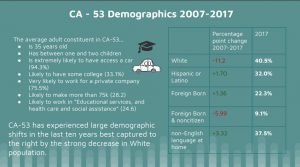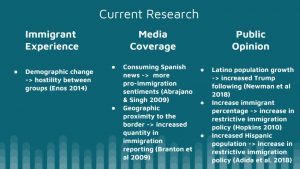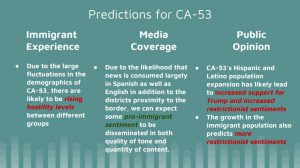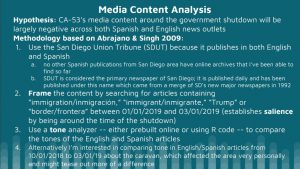

CA-53 and the San Diego region as a whole have been experiencing demographic shifts over the last twenty years in response to economic push/pull, urban sprawl leading to the expansion of downtown, and immigration. As seen in the table, the White population has sharply declined in the last ten years and are being replaced by small growths in minority populations. 1.7 percentage points of this growth are Hispanic or Latino residents, which is a small change in comparison to the White decline but a large change in comparison to more stable districts. This small increase is accompanied by a small immigrant increase, a sizeable decrease in undocumented immigrant presence, and a growth in non-English speaking households. The juxtaposition between CA-53 being very well educated and having a large percentage of non-English speaking households serves as evidence of the strong immigrant population base that exists in the district.

The current research on the topics is plentiful, and the more relevant conclusions for my scope fall under media and public opinion. For immigrant experience, I use Enos’ “Causal effect of intergroup contact on exclusionary attitudes.” Media coverage is represented by Abrajano and Hajnal’s White Backlash and Branton et al.’s “Slated Newspaper Coverage of Immigration: The Importance of Economics and Geography.” Public opinion is represented by Newman et al.s’ “Race, Place, and Building a Base: Latino Population Growth and the Nascent Trump Campaign for President,” Hopkins’ “Politicized Places: Explaining Where and When Immigrants Provoke Local Opposition” and Adida et al.’s “Ebola, elections, and immigration: how politicizing an epidemic can shape public attitudes.” When compiling this slide, I noticed a potential disconnect between restrictionist sentiments drawn out by increases in Hispanic, Latino or immigrant communities and the increase in Spanish language news that likely follows them there. I focus on this potential disconnect in my research proposal but it is worth noting here because the directionality of the predictions are opposite for the same changes in the same data.

The current research fits my district rather well because the Hispanic and Latino populations grew, the immigrant population grew, and the White population declined. Although the magnitude of the change is not large, the presence of the increase in minority populations primes the predictions to lean towards restrictionist predictions. The consensus of the ‘Immigrant Experience’ and ‘Public Opinion’ columns is that these changes will produce more restrictionist and conservative sentiments in CA-53; however, both articles under ‘Media Coverage’ expect more pro-immigrant rhetoric to spread.
 Notably, the research on immigrant experience and public opinion predict negative outcomes in terms of immigrant interests in CA-53, but media content still indicates positive sentiments about immigration. It is economically prudent for news outlets to appeal to the views of their consumers, so I predict that CA-53’s media content around the government shutdown — when special national attention was placed on immigration — will be largely negative across both Spanish and English news outlets. I am making a large assumption that CA-53’s large Spanish-speaking population translates into a large Spanish-news consuming population so that the results can be discussed as representative of CA-53. An obstacle I mention in the slide is that online databases, Lexis-Nexis included, do not carry any local news sources for the region below LA. The local Spanish papers — La Prensa, El Latino, and El Sol de San Diego — do not provide access to online archives of past issues. Currently I am looking at the San Diego Union Tribune, which publishes mostly in English but to a lesser extent in Spanish. I will account for the differences in sample size before I perform any tests or comparisons between the two languages. I have performed textual tone analysis using R in the past and could recreate that for the purposes of this project, or use one of the services available online; however, my concern with using a prebuilt system is its potential inability to handle Spanish. Another element I am considering is supplementing the results with a tone analysis of articles more explicitly about the migrant caravan, which had a huge impact on local communities. My logic is that the local salience of the migrant caravan will elicit a more direct response in local papers than the more broad concepts of the border/immigration/Trump.
Notably, the research on immigrant experience and public opinion predict negative outcomes in terms of immigrant interests in CA-53, but media content still indicates positive sentiments about immigration. It is economically prudent for news outlets to appeal to the views of their consumers, so I predict that CA-53’s media content around the government shutdown — when special national attention was placed on immigration — will be largely negative across both Spanish and English news outlets. I am making a large assumption that CA-53’s large Spanish-speaking population translates into a large Spanish-news consuming population so that the results can be discussed as representative of CA-53. An obstacle I mention in the slide is that online databases, Lexis-Nexis included, do not carry any local news sources for the region below LA. The local Spanish papers — La Prensa, El Latino, and El Sol de San Diego — do not provide access to online archives of past issues. Currently I am looking at the San Diego Union Tribune, which publishes mostly in English but to a lesser extent in Spanish. I will account for the differences in sample size before I perform any tests or comparisons between the two languages. I have performed textual tone analysis using R in the past and could recreate that for the purposes of this project, or use one of the services available online; however, my concern with using a prebuilt system is its potential inability to handle Spanish. Another element I am considering is supplementing the results with a tone analysis of articles more explicitly about the migrant caravan, which had a huge impact on local communities. My logic is that the local salience of the migrant caravan will elicit a more direct response in local papers than the more broad concepts of the border/immigration/Trump.